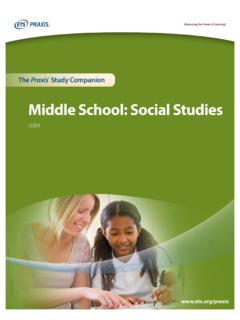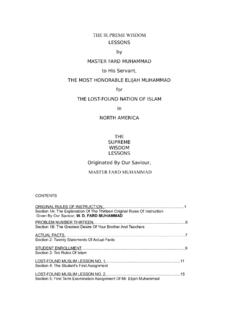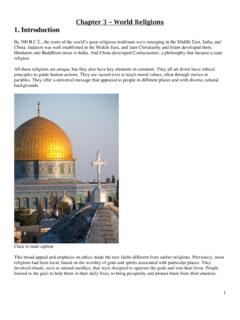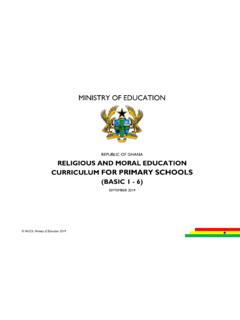Transcription of GLOBAL HISTORY & GEOGRAPHY - White Plains Public Schools
1 GLOBAL HISTORY & GEOGRAPHY REGENTS REVIEW PACKET Introduction: Included within this study guide is a summary of the information that frequently appears on the GLOBAL HISTORY and GEOGRAPHY Regents Exam. Although this review packet is intended to familiarize you with material that you are likely to encounter on the multiple-choice portion of the test, studying this information will also provide you with the background knowledge needed to write successful thematic and essays. Contents: Information in this packet is presented mainly in a chronological manner. Topics that you learned in 9th grade are covered in the first section, while the material that you studied as sophomores appears in Part II.
2 TABLE OF CONTENTS- Use this section to locate specific topics from Part I and Part II PART I- GLOBAL HISTORY and GEOGRAPHY I PART II- GLOBAL HISTORY and GEOGRAPHY II Created by Mr. Russo White Plains High School 550 North Street White Plains , NY 10605 2 TABLE OF CONTENTS PART I: GLOBAL HISTORY & GEOGRAPHY I Introduction to GLOBAL 5 Social Scientists Historical sources (Primary vs. Secondary Sources) Neolithic 5 Ancient 6 Civilizations Defined Ancient River Valley Civz.
3 (Egypt; Mesopotamia; Indus; China) Classical 7-8 Introduction to Classical Civilizations Greece (Athens; Sparta; Alexander the Great); Rome; India (Maurya and Gupta Dynasties; Caste System); China (Qin and Han Dynasties); Silk Road World Religions and 9 Monotheistic Religions (Judaism; islam ; Christianity) Religions and Philosophies of India (Hinduism; Buddhism) Philosophies of China (Legalism; Confucianism) Nature Religions (Shinto; Animism) Byzantine 10 Legal Systems of the Ancient and Classical 10 Code of Hammurabi; Twelve Tables of Rome; Justinian Code Golden Age of 10-11 Beliefs of islam Golden Age of islam Middle 11 Introduction to the Middle Ages (Feudalism; Manorialism) Crusades Golden Age of China (Tang and Song Dynasties)..Page 12 Early Japanese 12-13 Japanese GEOGRAPHY Japanese Religion (Shinto) Influence of China on Japan Japanese Feudalism (Shogun; Daimyo; Samurai) African 13 Intro to Africa ( GEOGRAPHY ; Animism; Bantu Migrations) West African Civilizations (Ghana; Mali; Songhai; Mansa Musa; Trade) The 13-14 Genghis Khan; Marco Polo Transformation of Western 14-15 Black Death ( Bubonic Plague) Renaissance (Humanism; Artists; Machiavelli) Protestant Reformation (Indulgences; Martin Luther; John Calvin; Henry VIII) Printing Press Pre-Columbian Civilizations of the 15-16 Maya; Aztec; Inca 3 Age of Exploration and 16-17 Exploration and Discovery (Causes; Explorers; Encomienda System; Mercantilism; Triangular Trade.)
4 Columbian Exchange) Commercial Revolution The Travelers of GLOBAL 17 Marco Polo; Ibn Battuta; Zheng He PART II: GLOBAL HISTORY & GEOGRAPHY II Age of 18 Absolute Monarchy; Divine Right; Peter the Great; Louis XIV Intellectual Revolutions of 18-19 Scientific Revolution (Copernicus; Galileo) Enlightenment (Natural Law; Locke; Montesquieu; Voltaire; Rousseau) Political 19-20 English (or Glorious) Revolution French Revolution (and Napoleon Bonaparte) Latin American Revolutions (Simon Bolivar; Toussaint L Ouverture) Industrial 21 Causes; Effects; Laissez-Faire Capitalism; Karl Marx 21-22 Unification of Italy and Germany Nationalism in Austria-Hungary and the Ottoman Empire Nationalism in Ireland (Potato Famine) 22-23 Introduction (Imperialism Defined; Causes of Imperialism) Imperialism in India, China, and Africa (Opium War; Spheres of Influence; Sepoy Mutiny; Boxer Rebellion) Imperialism in Japan (Commodore Perry; Meiji Restoration) World War 23-24 Causes; Treaty of Versailles; Effects Russian (or Bolshevik) 24 Causes; Bolsheviks; Vladimir Lenin; Effects Nationalism Between World 24-25 Turkey (Kemal Ataturk); Zionism; India (Mohandas Gandhi) Totalitarianism Between World 25-26 Introduction to Totalitarianism Joseph Stalin (Command Economy; Collectivization; Five Year Plans) World War 26-27 Events Leading to WWII (Japanese Aggression; Hitler; Appeasement) Key Events of WWII (Key Battles; Holocaust; Atomic Bomb) Effects of WWII (United Nations.
5 Nuremberg Trials) Cold 27-28 Iron Curtain, Containment; Berlin Wall; Berlin Airlift; Containment; NATO; Warsaw Pact; Cuban Missile Crisis; Korean War; Vietnam War Economic Issues after World War 28 Economic Cooperation (European Union; NAFTA) Oil Politics (OPEC) Communism in 28-29 4 Mao Zedong; Great Leap Forward; Cultural Revolution; Deng Xiaoping; Tiananmen Square Protests 29-30 Decolonization in India (Indian Independence; Pakistan; Kashmir) Decolonization in Africa (Jomo Kenyatta; Kwame Nkrumah; Apartheid; Nelson Mandela; Rwandan Genocide) Decolonization in Southeast Asia (Vietnam; Cambodia; Pol Pot; Khmer Rouge) Nationalist Leaders (Summary of Key Leaders) Middle East after World War 31 Creation of Israel (Israelis vs.
6 Palestinians) Islamic Fundamentalism (Iranian Revolution; Taliban) Collapse of 31 In Soviet Union (Mikhail Gorbachev; Perestroika; Glasnost) In Germany (Fall of the Berlin Wall) Human Rights 32 Armenian Massacre; Ukrainian Famine; Holocaust; Rwanda; Cambodia, Yugoslavia Economic 32 Traditional Economy; Market (or Capitalist/Laissez-Faire ) Economy; Command (or Communist) Economy Recent Issues and 32-33 Ethnic Conflicts (Palestinians, Tibet, Kurds, Chechnyans; etc.) Environmental Problems (Ozone Layer; Deforestation; Desertification; Greenhouse Effect; etc.) Science and Technology (Green Revolution; Nuclear Proliferation) 5 PART I: GLOBAL HISTORY & GEOGRAPHY I TOPIC: INTRODUCTION TO GLOBAL HISTORY AND GEOGRAPHY I.
7 Social Scientists A) The people who study the world in which humans live are known as social scientists. Below is a description of various social scientists and what it is that they study : 1) Historians- study written records of past events. 2) Geographers- study the Earth s surface and its impact on humans. Geographers often examine topography (physical land features), climate (weather), human migrations (movement), and the way in which humans adapt to (learn to live in) different environments. Geographers will often examine two types of maps: a) Political Maps- Show countries, their borders, and capital cities. b) Physical Maps- Show topography (land features such as mountains, rivers, deserts, lakes, etc.). 3) Economists- study how societies use available resources.
8 They often ask and try to answer the following 3 questions about civilizations: What goods and services are produced? How are goods and services produced? How are goods and services distributed? 4) Anthropologists- study past and present human cultures. Archaeologists are a type of anthropologist. They examine the culture of past human societies through analysis of physical remains (artifacts). II. Historical Sources A) Historians are concerned with the examination of written records from the past. There are two types of sources that historians study : 1) Primary Source- A firsthand record of a historical event created by an eyewitness who actually experienced the event (Examples- Diaries, photographs, artifacts, autobiographies). 2) Secondary Source- A secondhand record of a historical event created by a person who did NOT actually experience the event (Examples- Textbooks, encyclopedias, biographies).
9 TOPIC: THE NEOLITHIC AGE (NEOLITHIC REVOLUTION) I. Neolithic Age (8000-3000 BC) A) Also called the New Stone Age. B) Key developments of this period: 1) Humans first discovered how to perform agriculture (farm) and domesticate (raise) animals for food and drink. 2) Humans switched from being nomads (people who wander from place to place hunting and gathering for food) to being settled farmers who lived in permanent villages. 3) Farming created a steady food supply (called a food surplus). 4) The permanent villages created during the Neolithic Age eventually turned into civilizations (SEE NEXT TOPIC BELOW). 5) The development of farming during this period was so important for humans that it is often called the Neolithic Revolution. 6 TOPIC: ANCIENT CIVILIZATIONS I. Civilization A) A civilization is a complex and highly organized society that includes a government, social classes, job specialization, a food surplus, writing, and religious beliefs.
10 B) Civilizations developed soon after humans discovered farming and settled down in permanent villages during the Neolithic Age. C) The first civilizations developed around 3000 in areas of land known as river valleys (low areas of land next to rivers). The reason civilizations developed in river valleys is because these areas had favorable GEOGRAPHY : 1) The flooding of rivers deposited silt on nearby lands that created fertile soil for farming. 2) People irrigated (watered) their crops with water from the nearby rivers. 3) Rivers provided a source of transportation. D) Early river valley civilizations developed around the following rivers: The Nile River in Egypt, the Tigris River and Euphrates River in the Middle East, the Indus River in India, and the Yellow River and Yangtze River in China (SEE BELOW FOR MORE INFO ON THESE CIVILIZATIONS).















